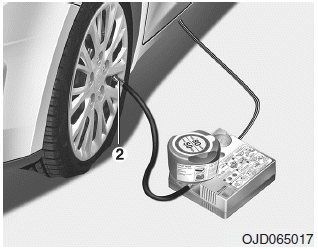Kia Cee'd: For 15, 16 inch tire / Checking the tire inflation pressure

1. After driving approximately 7~10 km (4~6 miles or about 10 min), stop at a safety location.
2. Connect the filling hose (2) of the compressor directly to the tire valve.
3. Plug the compressor power cord into the vehicle power outlet.
4. Adjust the tire inflation pressure to the recomended tire inflation. With the ignition swithched on, proceed as follows.
- To increase the inflation pressure
: Switch on the compressor,
position I. To check the current
inflation pressure setting, briefly
switch off the compressor.
- To reduce the inflation pressure:
Press the button (8) on the
compressor.
✽ NOTICE
Do not let the compressor run for more than 10 minutes, otherwise the device will overheat and may be damaged.
✽ NOTICE
The pressure gauge may show higher than actual reading when the compressor is running. To get an accurate tire reading, the compressor needs to be turned off.
CAUTION
If the inflation pressure is not maintained, drive the vehicle a second time, refer to Distributing the sealant. Then repeat steps 1 to 4.
Use of the TMK may be ineffectual for tire damage larger than approximately 4 mm (0.16 in). We recommend that you contact an authorized Kia dealer if the tire cannot be made roadworthy with the Tire Mobility Kit.
WARNING
The tire inflation pressure must be at least 220 kPa (32 psi). If it is not, do not continue driving. Call for road side service or towing.
CAUTION - Tire pressure sensor
The sealant on the tire pressure sensor and wheel should be removed when you replace the tire with a new one and inspect the tire pressure sensors at an authorized dealer.
 Using the Tire Mobility Kit
Using the Tire Mobility Kit
CAUTION
Detach the speed restriction
label (0) from the sealant bottle
(1), and place it in a highly visible
place inside the vehicle
such as on the steering wheel to
remind the driver no ...
 For 17, 18 inch tire
For 17, 18 inch tire
For safe operation, carefully read
and follow the instructions in this
manual before use.
(1) Compressor
(2) Sealant bottle
The Tire Mobility Kit is a temporary
fix to the tire and we recom ...
Other information:
Kia Cee'd JD Service Manual: Rear Wheel Guard Repair procedures
Replacement
•
When prying with a flat-tip screwdriver, wrap it with protective
tape, and apply protective tape around the related parts, to
prevent damage.
...
Kia Cee'd JD Service Manual: Main Crash Pad Assembly Repair procedures
Replacement
•
When prying with a flat-tip screwdriver, wrap it with protective
tape, and apply protective tape around the related parts, to
prevent damage.
...
